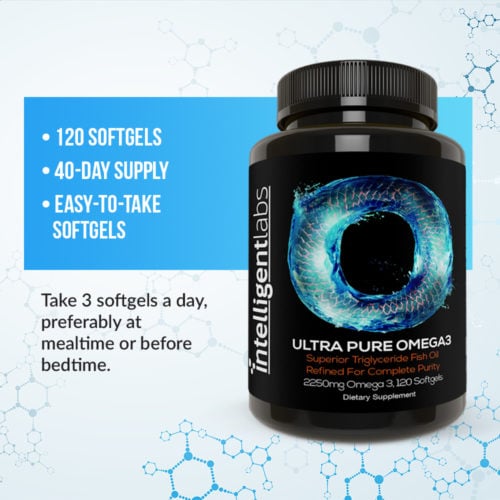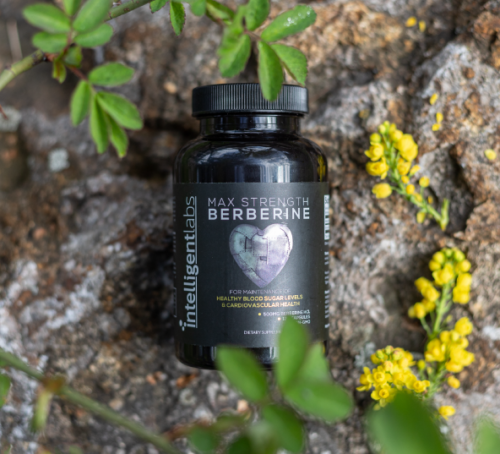Nutrition
How To Increase Insulin Sensitivity Naturally
You can’t turn on the radio or flick through a magazine without hearing someone talking about the rise in obesity and type 2 diabetes. Insulin resistance is one of today’s hot topics and one of the biggest challenges to our health. It’s a key cause of diabetes, high blood fat levels, and hypertension.
The good thing is, chronic disease doesn’t have to be our destiny. For instance, we can make a few tweaks to our diets and take supplements that are scientifically proven to help improve insulin sensitivity (e.g. our Ultra Pure Omega-3 and Berberine). Some of the changes may be challenging, but some may also be fun! That said, here are 7 ways to increase insulin sensitivity naturally.
Table of Contents
1) Cut the carbs
Insulin is released when we eat carbohydrates. Refined sugar makes the insulin spike higher than complex carbs, but the truth is that reducing our carbohydrate intake overall will make us produce less insulin.
As insulin helps to store fat, less circulating insulin can prevent, reduce or reverse weight gain. Protein and fat are filling too, so people on low carb diets tend to be less hungry and naturally eat fewer calories. Put simply, low-carbing (1) works to help you lose weight and improve your insulin sensitivity.
So cut out all refined sugar and white carbs, even moderate amounts can reduce insulin sensitivity (2). Don’t push it too far, though; get complex carbs from plenty of veggies and berries, nuts, and seeds.
If you go into a state of ketosis, where your body adapts to burning fat instead of glucose as its fuel, your tissues may develop a degree of insulin resistance as a protective mechanism to save up any glucose for the brain (3).
Related article: Low Carb vs Keto: Which Is Better and More Sustainable?
2) Lift heavy or HIIT it
Exercising can increase your insulin sensitivity but you’ve got to do it right. Long hours pounding the pavements or the treadmill can actually increase the amount of cortisol you release and make you more resistant to insulin. Instead, lift weights or try high impact interval training (HIIT) to improve your metabolic profile and your body.
It’s all down to a hormone called cortisol. Cortisol has a vital physiological role as one of the body’s stress hormones, helping us run faster, and fight harder. However, it also decreases our sensitivity to insulin (4), particularly if levels are high for long periods. The time and intensity of exercise can affect the level of cortisol release.
When it comes to exercise, more may not be better. Training for more than 60 minutes, even at a low intensity, will burn up the body’s glycogen stores and stimulate cortisol release. A study (5) confirmed that long-term cortisol exposure was significantly higher in endurance athletes.
Short high-intensity exercises such as sprints, HIIT, or weight training cause less of an increase in plasma cortisol concentrations. However, the levels tend to surge if rest periods are short and work levels are high. This is particularly significant if exercising when starved or nutritionally depleted. It is also increased by training in the early morning when cortisol levels are naturally higher (6), and the response to exercise can be more. So a hard 6am workout before breakfast may actually be counterproductive for improving insulin sensitivity.
3) Bump up the Omega 3
There is more and more evidence suggesting that dietary omega-3 may be one way in which we can improve insulin sensitivity and reduce the incidence of type 2 diabetes. Higher levels in the diet or measured in the bloodstream have been shown to make a real difference.

Early studies have shown (7) that supplementing with omega 3 from fish oils can improve the use of glucose by the body and reduce insulin resistance (8).
So, pack your diet with plenty of fish, and particularly oily fish, to give your omega 3 a boost. Mackerel, sardines, salmon, tuna, and crab will all increase your levels whether they’re frozen, fresh, or from a tin.
To get enough omega, you’ll need to eat fish or other seafood at least 1 to 2 times per week. Ideally, though, eat seafood every day if you want to see a big difference in insulin sensitivity, particularly choosing the dark fattier meat that is richer in essential fatty acids.
If seafood isn’t your thing, then take an Omega-3 supplement to get all the omega-3 you need, with no fishy flavour.
4) Spice up your life
This might sound surprising but if you want to know how to increase insulin sensitivity naturally, add a little flavour to the foods you eat. Research (9) shows that if your insulin resistance is high due to too many late nights and not enough sleep, then cinnamon can reverse that effect. Just don’t sprinkle it on a doughnut.
If you prefer something more savoury, try cooking with ginger, garlic, and turmeric (10, 11). You’ll knock up some killer curries, and you can also help improve your glucose tolerance and sensitize your body to the actions of insulin, a definite win all around.
5) Catch some rays (a little known tip on how to increase insulin sensitivity naturally)
Our bodies can make vitamin D in sunlight and it’s often reinforced in our foods. Even so, working in offices, being tied to our screens and consoles, and lavish application of sunscreen have caused lots of us to lack Vitamin D.
Rickets may be rare but too little vitamin D can lead to other problems. Researchers have linked low vitamin D levels to insulin resistance and type 2 diabetes. So, give your levels a boost with a little sunshine, plenty of oily fish, dairy produce, and liver. It can be difficult to increase your vitamin D levels through diet alone, so consider a daily supplement too (12).
6) Get some love
Sounds too good to be true? Well, believe it, love could actually protect you from diabetes. The effect seems to be linked to oxytocin, the hormone that is linked to love and bonding. Oxytocin is released when a mother breastfeeds her baby, but our levels surge if we snuggle up to a loved one, bond with someone socially, or even pet our dogs. There’s a reason it’s known as the ‘cuddle hormone.’
If oxytocin is given to us, we tend to feel calmer, happier, and safer. But it can also have effects on our response to insulin. A study demonstrated that oxytocin acted to reverse insulin resistance and improve glucose tolerance in obese mice (13). Maybe love really is a drug.
7) Take Berberine

For our last tip on how to increase insulin sensitivity naturally, check out Berberine.
Berberine is found in several different plants, including European barberry, Oregon grape, goldenseal, goldthread, philodendron, and tree turmeric. Berberine can reduce glucose production in the liver (14, 15).
Berberine has antibacterial, anti-inflammatory, and immune-enhancing effects. It has also been shown to increase insulin sensitivity (16, 17, 18, 19, 20).
Final words
Any of the tips above on how to increase insulin sensitivity naturally can help you improve your health. Additionally, recent research also shows that inositol powder may be another supplement that may help reduce insulin resistance.
💬 Something on your mind? Share your thoughts in the comments. We love hearing from curious minds.
📩 And while you’re here, join our newsletter for more smart stuff (and secret perks)!
References:
(1) The Journal Of Nutrition – jn.nutrition.org
(2) Moderate amounts of fructose consumption impair insulin sensitivity in healthy young men: a randomized controlled trial, Isabelle Aeberli, Michel Hochuli, Philip A Gerber, Lisa Sze, Stefanie B Murer, Luc Tappy, Giatgen A Spinas, Kaspar Berneis, Diabetes Care. 2013 Jan;36(1):150-6.
(3) Elevated hair cortisol concentrations in endurance athletes, Nadine Skoluda, Lucia Dettenborn, Tobias Stalder, Clemens Kirschbaum, Psychoneuroendocrinology. 2012 May;37(5):611-7.
(4) Cortisol and Growth Hormone Responses to Exercise at Different Times of Day, Jill A. Kanaley, Judy Y. Weltman, Karen S. Pieper, Arthur Weltman, Mark L. Hartman, The Journal of Clinical Endocrinology & Metabolism, Volume 86, Issue 6, 1 June 2001, Pages 2881–2889.
(5) Phospholipids from herring roe improve plasma lipids and glucose tolerance in healthy, young adults, Bodil Bjørndal, Elin Strand, Jennifer Gjerde, Pavol Bohov, Asbjørn Svardal, Bernd Wk Diehl, Sheila M Innis, Alvin Berger, Rolf K Berge, Lipids Health Dis. 2014 May 17;13:82.
(6) DHA at nutritional doses restores insulin sensitivity in skeletal muscle by preventing lipotoxicity and inflammation, J Nutr Biochem. 2015 Sep;26(9):949-59.
(7) Cassia cinnamon for the attenuation of glucose intolerance and insulin resistance resulting from sleep loss, Jean Jitomir, Darryn S Willoughby, J Med Food. 2009 Jun;12(3):467-72.
(8) Effects of ginger (Zingiber officinale) on plasma glucose level, HbA1c and insulin sensitivity in type 2 diabetic patients, Sepide Mahluji,Vahide Ebrahimzade Attari… Pages 682-686.
(9) Anti-hyperglycemic and insulin sensitizer effects of turmeric and its principle constituent curcumin, Zeinab Ghorbani, Azita Hekmatdoost, Parvin Mirmiran, Int J Endocrinol Metab. 2014 Oct 1;12(4):e18081.
(10) The effect of vitamin D on insulin resistance in patients with type 2 diabetes, Afsaneh Talaei, Mahnaz Mohamadi & Zahra Adgi, Published: 26 February 2013.
(11) Treatment of Obesity and Diabetes Using Oxytocin or Analogs in Patients and Mouse Models, Hai Zhang ,Chenguang Wu ,Qiaofen Chen,Xiaoluo Chen,Zhigang Xu,Jing Wu,Dongsheng Cai, Published: May 20, 2013.
(12) Berberine in the treatment of type 2 diabetes mellitus: a systemic review and meta-analysis, Hui Dong, Nan Wang, Li Zhao, Fuer Lu, Evid Based Complement Alternat Med. 2012;2012:591654.
(13) Berberine’for’Diabetes’Mellitus’Type’2, By Ronald Steriti, ND, PhD, 2010.
(14) Berberine inhibits PTP1B activity and mimics insulin action, Chunhua Chen, Yuebo Zhang, Cheng Huang, Biochem Biophys Res Commun. 2010 Jul 2;397(3):543-7.
(15) Berberine and its more biologically available derivative, dihydroberberine, inhibit mitochondrial respiratory complex I: a mechanism for the action of berberine to activate AMP-activated protein kinase and improve insulin action, Nigel Turner, Jing-Ya Li, Alison Gosby, Sabrina W C To, Zhe Cheng, Hiroyuki Miyoshi… Diabetes. 2008 May;57(5):1414-8.
(16) Berberine, a natural plant product, activates AMP-activated protein kinase with beneficial metabolic effects in diabetic and insulin-resistant states, Yun S Lee, Woo S Kim, Kang H Kim, Myung J Yoon… Diabetes. 2006 Aug;55(8):2256-64.
(17) Berberine-induced activation of 5′-adenosine monophosphate-activated protein kinase and glucose transport in rat skeletal muscles, Xiao Ma, Tatsuro Egawa, Hajime Kimura… Metabolism. 2010 Nov;59(11):1619-27.
(18) AMP-activated protein kinase: a potential target for the diseases prevention by natural occurring polyphenols, Jin-Taek Hwang, Dae Young Kwon, Suk Hoo Yoon, New Biotechnology, Volume 26, Issues 1–2, 1 October 2009, Pages 17-22.
(19) A high-fat, ketogenic diet causes hepatic insulin resistance in mice, despite increasing energy expenditure and preventing weight gain, François R Jornayvaz 1, Michael J Jurczak, Hui-Young Lee… Am J Physiol Endocrinol Metab. 2010 Nov;299(5):E808-15.
(20) The effects of cortisol on insulin sensitivity in muscle, A. HOLMÄNG, P. BJÖRNTORP, Acta Physiologica Scandinavica, Volume 144, Issue 4 p. 425-431.





